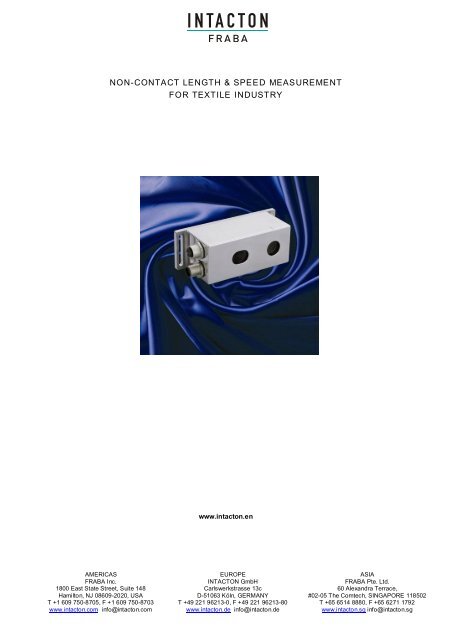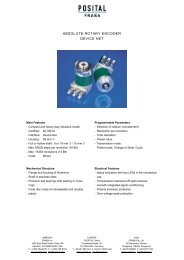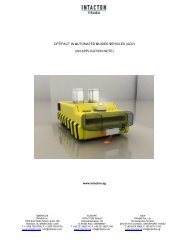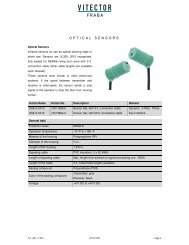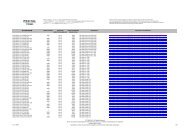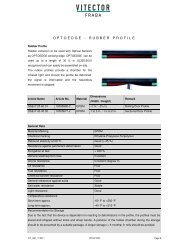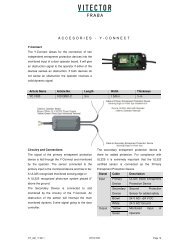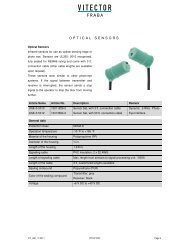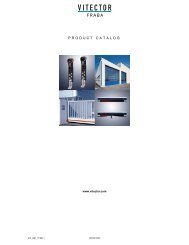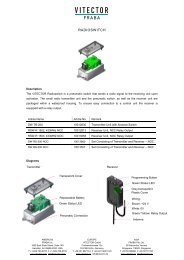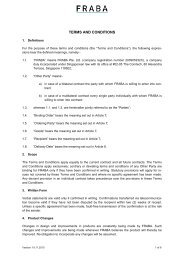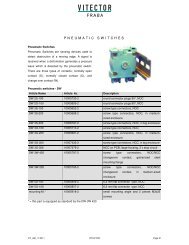Absolute Winkelcodierer OCD Powerlink
Absolute Winkelcodierer OCD Powerlink
Absolute Winkelcodierer OCD Powerlink
Create successful ePaper yourself
Turn your PDF publications into a flip-book with our unique Google optimized e-Paper software.
AMERICAS<br />
FRABA Inc.<br />
1800 East State Street, Suite 148<br />
Hamilton, NJ 08609-2020, USA<br />
T +1 609 750-8705, F +1 609 750-8703<br />
www.intacton.com info@intacton.com<br />
NON-CONTACT LENGTH & SPEED MEASUREMENT<br />
FOR TEXTILE INDUSTRY<br />
www.intacton.en<br />
EUROPE<br />
INTACTON GmbH<br />
Carlswerkstrasse 13c<br />
D-51063 Köln, GERMANY<br />
T +49 221 96213-0, F +49 221 96213-80<br />
www.intacton.de info@intacton.de<br />
ASIA<br />
FRABA Pte. Ltd.<br />
60 Alexandra Terrace,<br />
#02-05 The Comtech, SINGAPORE 118502<br />
T +65 6514 8880, F +65 6271 1792<br />
www.intacton.sg info@intacton.sg
Background<br />
Length and speed are two essential measurement<br />
parameters which are prominent in textile indus-<br />
tries worldwide. For optimal quality at textile print-<br />
ing, cutting, textile power loom and spinning mill<br />
processes, the accurate determination of these<br />
parameters is required, to avoid wastage and<br />
meanwhile minimize the production costs.<br />
The commonly used solutions, like measurement<br />
wheels combined with incremental encoders bring<br />
forth many problems. One of the biggest problems<br />
for achieving ideal process control is slippage in<br />
measurements. This leads to significant measure-<br />
ment errors in for example, cutting applications.<br />
Furthermore, the contact measuring principle has<br />
the risk of surface contamination and often leaves<br />
unwanted residue and marks on the textile’s sur-<br />
faces.<br />
Hence, the use of such conventional systems is<br />
limited and is considered unsuitable for use over<br />
sensitive surfaces. Furthermore, these convention-<br />
al measurement systems need to be constantly<br />
monitored and hence increasing installation and<br />
maintenance costs manifold.<br />
Optical Alternative<br />
The two non-contact sensors, COVIDIS and OP-<br />
TIPACT, offer an optical alternative through slip<br />
free accurate length and velocity measurement.<br />
These sensors are specially designed for applica-<br />
tions where feed- motion, length, velocity or differ-<br />
ences requires measurement. Due to the non-<br />
contact technology, they are ideally suited for<br />
measuring applications in the textile industry,<br />
where measurements are of fine and sensitive<br />
materials.<br />
Typical Applications<br />
A broad and diverse range of applications in the<br />
textile industry are covered by two non-contact<br />
sensors, COVIDIS and OPTIPACT. COVIDIS is a<br />
high-end sensor, with a measurement uncertainty<br />
of less than 0.05%. It is especially suitable for very<br />
fast moving applications (up to 50 m/s) requiring<br />
high precision. OPTIPACT sensors are available<br />
with different configurations depending on the<br />
surface and speed of the measurand. They are<br />
used in applications with slower travelling speeds<br />
(up to 4 m/s) and are used as smart 2- Axis mea-<br />
surement sensors. This is a one of a kind, low cost<br />
sensor, which provides contact free 2 dimensional<br />
measurements and can be used to directly replace<br />
encoders with measuring wheels.<br />
Page 2 Textile Applications Version 1.0<br />
06/2011
Measurement of inlet speed<br />
SANFOR® Process – Measurement Issues<br />
Pressure<br />
Zone<br />
SANFOR® Process is the defined shrinking<br />
process in textiles and cotton before use. The<br />
initial process includes moistening the material and<br />
passing of textile into the pressure zone, where it<br />
is heated and stretched. After leaving the pressure<br />
zone, the fabric is sent through rollers to remove<br />
the moisture. This in turn, shrinks the fabric. A<br />
regulated shrinking process ensures consistent<br />
quality. This quality is determined by the inlet and<br />
outlet velocity of the textile, in and out of the pres-<br />
sure zone. The exact knowledge of these parame-<br />
ters is essential for process control.<br />
SANFOR® Process – Optical Alternative<br />
INTACTON presents the possibility of a precise<br />
non-contact optical velocity measurement without<br />
errors caused by slippage. Therefore no contami-<br />
nation or marks are left on the sensitive surface.<br />
Furthermore a two dimensional measurement can<br />
be performed. Thereby not only the velocity of feed<br />
but also elongation or deformation of the material<br />
can be detected. An over speed can be signaled<br />
by digital outputs, where the maximum speed is<br />
adjustable. Furthermore, the quality of measure-<br />
ment can be monitored by the diagnostic outputs.<br />
Thus, the shrinkage can be optimally adjusted<br />
using the accurate measurement feedback to en-<br />
sure a reproducible quality of the material.<br />
Measurement of outlet speed<br />
Textile Coating & Dyeing –Measurement Issues<br />
Textile coating and dyeing machinery often involve<br />
several textile finishing and lamination stages. In<br />
such applications the properties of the textile are<br />
changed in terms of water / chemical / light resis-<br />
tance or surface design. During the process sever-<br />
al coatings run over each other. Dimensional<br />
changes in terms of linear expansion and deforma-<br />
tion of the material require dynamic measurements<br />
to be done. The use of conventional measurement<br />
systems are unable to do so, and will lead to a loss<br />
of quality owing to measurement errors. This appli-<br />
cation in particular requires a feed speed control<br />
and a targeted re-adjustment for pre-defined<br />
process control.<br />
Textile Coating & Dyeing – Optical Alternative<br />
INTACTON’s optical motion sensors are designed<br />
for non-contact, optical, speed and length mea-<br />
surement in 2 dimensions even under varying<br />
measurement conditions. The sensors can work<br />
even under deviation of working distance and<br />
varying image rates (anything above the minimum<br />
requirement). The 2D measurement is also helpful<br />
in detecting any deformations and can enable the<br />
user to adjust the control parameters accordingly.<br />
Suffice to say. OPTIPACT and COVIDIS are con-<br />
venient solutions for speed control, length mea-<br />
surement and deformation indication in textile<br />
coating applications.<br />
Page 3 Textile Applications Version 1.0<br />
06/2011
Measurement in 2-D<br />
Textile Cutting and Printing – Measurement<br />
Issues<br />
Textile cutting and printing processes require accu-<br />
rate length measurement for precise cutting and<br />
design of the fabric, in order to, minimize the was-<br />
tage and therefore reduce the material costs. For<br />
defined stacking and cutting processes a precise<br />
measurement of these parameters is always re-<br />
quired. The slippage in conventional measurement<br />
tools involving wheels and incremental encoder is<br />
a major hindrance in such machinery. Furthermore<br />
velocity variations particularly during roll changing<br />
processes, often leads to measurement errors. The<br />
possibility of a constant speed control or detection<br />
of over speed will also be required.<br />
Textile Cutting and Printing – Optical Alterna-<br />
tive<br />
The optical non-contact principle once again<br />
comes into operation. Such consistent and accu-<br />
rate measurement feedback enables the control<br />
system to define a steady process control, to re-<br />
duce material wastage and ultimately minimize the<br />
production costs. The digital outputs can be used<br />
to detect any over speed in the fabric feed or sig-<br />
nal a pre-determined length. Since all the sensors<br />
can detect standstill in both forward and backward<br />
directions it makes the measurement system even<br />
more flexible.<br />
Spinning Mills and Power loom– Measurement<br />
Issues<br />
In spinning mills and textile power looms the<br />
supply and outlet speed of yarn, thread and fabric<br />
are continuously monitored. The machinery re-<br />
quires long range length and high velocity mea-<br />
surements. The conventionally used measurement<br />
systems often endanger the production and cause<br />
a lot of material wastage because of improper<br />
measurements due to variations in measurement<br />
conditions and constraints on length and velocity<br />
measurements. Machinery with measurement<br />
wheels suffered the most with very high errors due<br />
to slippage and high rate of textile deformation and<br />
wastage.<br />
Spinning Mills and Power loom– Optical Alter-<br />
native<br />
The non-contact optical measurement sensors<br />
from INTACTON are ideal for usage in spinning<br />
mills and power looms as they provide accurate<br />
measurements without causing any textile defor-<br />
mation or high material wastage. Moreover, COVI-<br />
DIS is already proved in this application and can<br />
measure high speeds of thread up to 50m/s with<br />
measurement uncertainties ≤ 0.05%. The mea-<br />
surement range of length is infinite and the sen-<br />
sors can measure over diverse range of textile<br />
materials leading to considerable cost savings.<br />
Page 4 Textile Applications Version 1.0<br />
06/2011
OPTIPACT<br />
Small, Flexible, Low Cost Units<br />
OPTIPACT sensors consist of an LED illumination<br />
unit, a 2D camera, miniaturized transmitting and<br />
receiving optics, and integrated analysis and inter-<br />
face electronics. With a size of 98 x 42 x 47 mm<br />
and weighing only 250 grams, the units can be<br />
easily integrated into almost any application. X-<br />
axis and Y-axis position data enable surveillance<br />
of movement in any direction – unlike in other<br />
systems, adjustment and calibration is not re-<br />
quired. The sensors are housed in an IP65-<br />
protected aluminum enclosure. They require a<br />
supply voltage of optionally +5 or 10…30 V. An<br />
incremental interface and an RS232 interface are<br />
available for communication with a higher-level<br />
PLC. INTACTON implements field bus systems or<br />
SSI on request. The sensors’ completely modular<br />
design enables easy adaptation to various specific<br />
requirements. The energy-efficient LED illumina-<br />
tion has the added advantage of requiring no ex-<br />
ternal illumination and hence less repair and ser-<br />
vice costs. Furthermore, unlike conventional optical<br />
systems, the OPTIPACT sensor is completely<br />
maintenance-free.<br />
Function principle<br />
The OPTIPACT system uses a very simple non-<br />
contact, slippage free measurement principle. It is<br />
basically a simple correlation method whereby the<br />
surface is observed by an area camera suitably<br />
illuminated by appropriate light sources. Displace-<br />
ment, direction and velocity are analyzed and<br />
calculated by comparing consecutive high resolu-<br />
tion surface pictures. Image correlation relies on<br />
image overlaps within a captured sequence of<br />
images. With increasing speed the overlap is re-<br />
duced. In consequence, the maximum detectable<br />
velocity depends on the optics design limiting the<br />
size of the field of view of the camera. This para-<br />
meter simultaneously influences the structures<br />
visible on the image, the essential basis of the<br />
image correlation calculations. The OPTIPACT<br />
sensors has different models, OPT-S/F/M, varying<br />
in the design of optics and therefore in the optical<br />
resolution. The optics of OPT-S was designed for<br />
velocities up to 4m/s. The optics of OPT-F has a<br />
four-time higher magnification, thereby the velocity<br />
range decrease to 1m/s, but enables measurement<br />
on fine structured surfaces.<br />
Page 5 Textile Applications Version 1.0<br />
06/2011
COVIDIS<br />
High Precision Measurement<br />
The core of the COVIDIS sensor system is a high<br />
speed line camera that detects light reflected from<br />
the object being measured. The basic measure-<br />
ment principle is based on further refinement of the<br />
tried-and-tested spatial frequency filtering technol-<br />
ogy. A grid structure is superimposed over the<br />
moving camera image, thus allowing a periodic<br />
output signal to be obtained, with a frequency<br />
proportional to the velocity. Using a time-related<br />
integration of the velocity signal, the distance cov-<br />
ered can be measured with an accuracy of 0.05%.<br />
The analysis of the data is achieved by advanced<br />
algorithm running on a powerful data processing<br />
platform. These sensor systems thus show a high<br />
degree of adaptability and can be used on a wide<br />
range of industrial surfaces. It is even possible to<br />
detect lack of motion or direction change in the<br />
object being measured, which is then taken into<br />
account in the measurement of distance covered.<br />
Using LED´s, an RS232 interface, and appropriate<br />
software, extensive configuration and diagnostic<br />
possibilities are available for users, thus facilitating<br />
the starting of operations as well as enabling pre-<br />
ventive maintenance.<br />
Measurand<br />
LED Illumination<br />
High Speed Camera<br />
Page 6 Textile Applications Version 1.0<br />
Lens<br />
FPGA/DSP Platform<br />
Material friendly, Maintenance-free Solution<br />
The main advantage of non-contact measurement<br />
solution above all factors is the reduced<br />
measurement error due to the lack of slippage and<br />
dynamic measurement capabilities. This blend of<br />
characteristics also minimizes costs. Furthermore,<br />
due to the non-contact principle, the surface under<br />
measurement is not damaged by pressure, which<br />
is especially important for sensitive materials.<br />
Effective process control is possible through<br />
numerous features like precise position and<br />
velocity feedback, detection of abnormal velocity<br />
through digital outputs, and quality of<br />
measurements through diagnostic outputs. The<br />
compact design enables a hassle free installation<br />
of the sensor even in places with constrained<br />
space and difficult access. In addition to the<br />
compact design, the simple graphical user<br />
interface provides an ideal solution for easy startup<br />
and operation of the sensor. The sensors require<br />
no mechanical connection and thus provide a<br />
reliable, maintenance-free and precise solution for<br />
effective measurements over a varied range of<br />
materials and providing ideal sensing solutions for<br />
effective quality control of a variety of processes.<br />
06/2011
Characteristics<br />
COVIDIS OPTIPACT-S OPTIPACT-F OPTIPACT-M<br />
Velocity Range ± 50 m/s ± 4 m/s ± 1 m/s ± 2,5 m/s<br />
Working Distance 300mm ±5% 40mm ±10% 15mm ±10% 180mm ±3%<br />
Measurement Uncertainty
INTACTON GmbH<br />
INTACTON GmbH was founded in 2004 as a<br />
FRABA Group enterprise. Based in Cologne, we<br />
develop, manufacture and distribute optical motion<br />
sensors for measurement of lengths and velocity.<br />
Since 2006, INTACTON has been establishing and<br />
extending a network of national and foreign distrib-<br />
utors that, even when far away from the firm’s<br />
headquarters, ensures competence in consultation<br />
in the local language. Manufacturers and users of<br />
production machines, textile manufacturers as well<br />
as companies in the fields of lift technology or<br />
special-purpose vehicles constitute the main cus-<br />
tomers of INTACTON.<br />
AMERICAS<br />
FRABA Inc.<br />
1800 East State Street, Suite 148<br />
Hamilton, NJ 08609-2020, USA<br />
T +1 609 750-8705, F +1 609 750-8703<br />
www.intacton.com info@intacton.com<br />
FRABA Group<br />
FRABA Group today comprises a set of companies<br />
focused on niches in the industrial automation<br />
market. The company was founded in Cologne,<br />
Germany in 1918 and initially manufactured relays<br />
in serial production. This focus was maintained<br />
until the mid sixties and provided the basis for<br />
entry into the control market, and over 13,000<br />
machine controls were installed. In the seventies,<br />
FRABA was the pioneer in developing the market<br />
for rotary absolute optical encoders. Today the<br />
subsidiary POSITAL develops and markets these<br />
sensors as well as inclination sensors. Since the<br />
90's, the subsidiary VITECTOR has become one of<br />
the leading manufacturers of safety sensors for<br />
doors and gates.<br />
EUROPE<br />
INTACTON GmbH<br />
Carlswerkstrasse 13c<br />
D-51063 Köln, GERMANY<br />
T +49 221 96213-0, F +49 221 96213-80<br />
www.intacton.de info@intacton.de<br />
ASIA<br />
FRABA Pte. Ltd.<br />
60 Alexandra Terrace,<br />
#02-05 The Comtech, SINGAPORE 118502<br />
T +65 6514 8880, F +65 6271 1792<br />
www.intacton.sg info@intacton.sg


